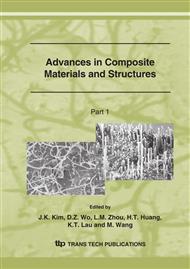p.521
p.525
p.529
p.533
p.537
p.541
p.545
p.549
p.553
Mechanical Properties of Vinyl Ester Composites Cured by Microwave Irradiation: Pilot Study
Abstract:
Composite components made from vinyl ester resins by Centre of Excellence in Engineered Fiber Composites (CEEFC), University of Southern Queensland (USQ) suffer considerable shrinkage during hardening. Currently, CEEFC solves the shrinkage problem by breaking a large composite component into smaller composite parts because smaller parts tend to have less shrinkage. These smaller parts are then joined together to form the overall structure. The shrinkage of vinyl ester particulate composites has been reduced by curing the resins under microwave conditions. The reduction in the shrinkage of the resins by microwaves will enable the manufacture of large vinyl ester composite items possible. This project investigates the difference in impact strength, tensile strength and Young’s modulus of 33 percent by weight of fly-ash particulate reinforced vinyl ester composite, VE/FLY-ASH (33%) cured under microwave and ambient conditions. Drop weight impact tests were used to find out the impact strength of the composite, while tensile tests were used to find out the tensile strength and Young’s modulus of the composite. The power levels of microwaves used were 180 and 360 W; the duration of exposure of the composite samples to microwave irradiation varied from 20 to 50 seconds. The difference in impact strength and Young’s modulus between microwave cured vinyl ester particulate composites and those cured under ambient conditions had been found to be minimal. However, the tensile strength of the composite samples cured under microwave conditions can be higher than those cured under ambient conditions.
Info:
Periodical:
Pages:
537-540
Citation:
Online since:
March 2007
Authors:
Price:
Сopyright:
© 2007 Trans Tech Publications Ltd. All Rights Reserved
Share:
Citation:


